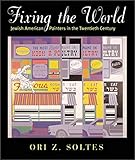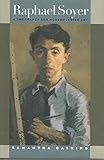Jewish-born artists flourished in the United States throughout the 20th century. A survey of their work reveals a rich and diverse range of styles and attitudes toward Jewish themes, from unconscious identifications with, to explicit dissociations from, Judaism and Jewish culture. This has engendered an intriguing puzzle that has haunted art historians for close to a hundred years: Is there such a thing as “Jewish art”? If so, what are its defining characteristics?
Fixing the World: Jewish American Painters in the Twentieth Century (Brandeis Series in American Jewish History, Culture and Life)
Brandeis University Press
160 pages
$6.39
Raphael Soyer and the Search for Modern Jewish Art
The University of North Carolina Press
280 pages
$9.08
By midcentury, the number of Jewish-born artists attracting market and critical attention had proliferated. Some were figurative painters. Others made their reputations as abstract expressionists. A few warmly avowed their Jewish heritage, while many feared rejection if they did so too explicitly. To complicate matters further, by century’s end a new generation of Jewish-born painters had come to maturity meditating on the Holocaust. In comparison with their immediate predecessors, their work reflects far less anxiety about reconciling Judaism with the demands of a secular society, and more with making sense of a mechanized world where murder can instantly reach epic proportions.
It would seem, then, that with each new generation and every new movement and style, any hope of resolving the enigma about Jewish art grows fainter. Yet, the scholarly mission to define Jewish art continues. Several new books address these questions with a freshness of presentation that merits close attention.
Fixing the World: Jewish American Painters in the Twentieth Century, by Ori Z. Soltes, is fairly brief but beautifully illustrated with color plates that trace the full scope of Jewish painting throughout the 20th century, especially in New York. The sweep of Soltes’ study is nothing less than epic. Beginning with 19th-century Europe, he examines paintings by Moritz Daniel Oppenheim and Camille Pisarro before turning his attention to 20th-century New York. Soltes presents a lavish series of plates that includes work by artists many of whom you probably never knew were Jewish: Philip Guston, Morris Lewis, and Larry Rivers, for example. His central premise is that Jewish art is motivated by the ancient religious injunction to fix the world—in Hebrew, tikkun olam. What holds these disparate stylists together in a single, identifiable category, Soltes argues, is their passionate concern for bringing justice to a fallen world.
Soltes is right on at least one point. Social commentary, even pungent critique, is often found in the work of Jewish artists. But he is not entirely convincing when arguing that tikkun olam is necessary or sufficient for identifying art as Jewish. Beginning in the mid-19th century, for example, many non-Jewish painters, such as Courbet and Daumier, assumed the role of social commentator, calling attention to the hypocrisy and injustice they perceived in the contemporary social order. On the other hand, there is barely an intimation of tikkun olam in paintings by some of the Jewish artists included in Soltes’ book, such as Modigliani, Samuel Halpert, and Louis Lozowick. Soltes’ emphasis on tikkun olam as the defining theme of Jewish art thus becomes strained to the point of incredulity at times. The chief merit of his study consists rather in its panoramic and well-illustrated survey, and the aesthetic insight he brings to individual paintings when he describes their purely visual elements. At least as he handles the subject, the Jewishness of the artists included in this volume appears to be little more than an incidental fact about them.
A far more comprehensive response to the question about Jewish art may be found in Masterworks of the Jewish Museum. That there exists something called Jewish art is left beyond doubt by the introductory essays and arrangement of material from the museum’s extraordinary collection. In response to the question, “What, then, are the defining characteristics of Jewish art?” the text provides a pluralistic answer through magnificent reproductions and insightful essays that explore four thousand years of religious, historical, cultural, stylistic, and political themes. The richness and diversity of works included in the book represent only a very small sample of the 28,000 individual pieces in the museum’s permanent collection. This contextual perspective alone should serve as an advisory to scholars who attempt a more simplified answer to questions about what constitutes Jewish art, especially those who concentrate primarily on New York.
This is a potential danger that faces Samantha Baskind, author of Raphael Soyer and the Search for Modern Jewish Art. Baskind focuses on just one painter from the 20th century, using very few color plates and only a handful of black-and-white illustrations of his work. An artist with credentials lesser-known to the general public, Raphael Soyer (1899-1987) arrived in America with his family at age ten. Throughout his life, he remained profoundly self-conscious and insecure about his situation: a Russian-born, heavily accented Jewish immigrant living in New York when anti-Semitism was still an active part of the local culture. In comments he made throughout his career, Soyer overtly disavowed the Jewishness of his art, preferring to identify himself instead as “a New York painter.” It was not until 1970, when he agreed to illustrate a collection of stories by Isaac Bashevis Singer, that Soyer consciously took up Jewish themes in his work. By then, he was 71 years old. Nevertheless, Baskind argues that Soyer’s art was explicitly Jewish throughout his life, his disclaimers on this point notwithstanding.
It is well to beware of art historians who audaciously claim to understand the work of their subjects better than these artists understood themselves. Baskind thus assumes a formidable burden of proof when she states that she will not take Soyer at his word when he claims that his art is not Jewish. But much to her credit, she does avoid hubris by paying meticulous attention to the evolution of Soyer’s style—which reflects his personal struggle, endured over an entire lifetime, with what it actually means to be Jewish.
The intellectual problem that art historians encounter when trying to define Jewish art is a difficulty for Jewish artists too when they bring the spiritual dimensions of their souls to artistic expression. Jewish art is so profoundly hard to define because there is no obvious or logical sense to being Jewish in the first place. Is someone a Jew as a matter of birth, even if that individual does not understand herself to be a Jew? Is someone Jewish because another identifies him as such, whether it is a Jew or anti-Semite handing out the labels? If one does recognize him- or herself to be Jewish, what constitutes the identification? Is it religious? Cultural? A sense of belonging to a Jewish community, or political kinship with Israel? And how are such modes of identity to be expressed aesthetically? Must tikkun olam play an essential part? How about the Holocaust, or Jewish religious observance and history?
To the best of my knowledge, no one has yet been able to answer these questions. But perhaps the resistance of the problem to aesthetic, philosophical or historical solution is part of the mystery, and thus the very sense, of what it means to be Jewish. Jews are the people who have to live and struggle with the question of what it means to be Jewish. To non-Jews who take up the problem, this is an intellectual puzzle at best or a political question at worst. But the personal and existential struggle with the meaning of the question, like Jacob wrestling with the mysterious stranger who eventually names him Israel, is part of what it is to have a Jewish identity at all.
Baskind understands this dimension of the problem as it manifests itself in the work of Raphael Soyer. This is an issue the artist wrestled with throughout his life, sometimes most poignantly in the manner in which he chose to avoid it. If it took seventy years for him to make a genuine discovery of his Jewishness, then Soyer was clearly ahead of many of us. As demanding as her burden of proof is, Baskind does her subject justice when she surveys Soyer’s conflicts with questions about his Jewish identity, and shows how the magnificent art he bequeathed to us as the legacy of this struggle was itself a contribution to tikkun olam.
In the end, though, I must return to Masterworks of the Jewish Museum as my aesthetic and historical compass. New York in the 20th century certainly posed unique challenges and availed extraordinary opportunities to artists of Jewish birth. But what about the preceding 39 centuries, and other Jewish communities scattered across the globe? What are they? Chopped liver?
To reduce the entirety of Jewish art to that produced in 20th-century New York is to miss a major point. Demanding that a single criterion be satisfied to identify art as Jewish in the first place misses a bigger point still. As Masterworks makes clear, whatever else it may be, Jewish art is collective memory personalized, consisting of diverse struggles with and meditations on the existential significance of Jewish identity, tragedy, joy, and transcendence. Four thousand years of such art can not be reduced to a single definition or category of meaning. By itself, the collection of the Jewish Museum testifies magnificently to this fact.
Mark Packer teaches in the Departments of Art History and Philosophy at University of South Carolina, Upstate in Spartanburg.
Copyright © 2005 by the author or Christianity Today/Books & Culture magazine. Click here for reprint information on Books & Culture.












